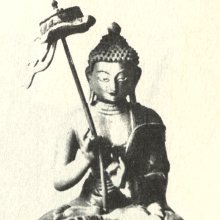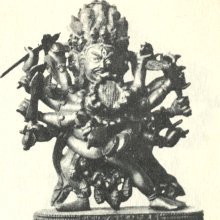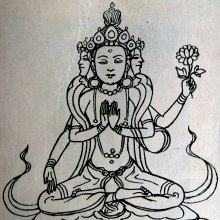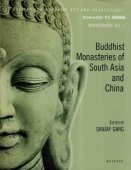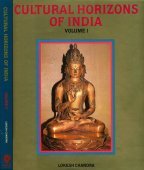Chang: 2 definitions
Introduction:
Chang means something in the history of ancient India, Hindi. If you want to know the exact meaning, history, etymology or English translation of this term then check out the descriptions on this page. Add your comment or reference to a book if you want to contribute to this summary article.
Ambiguity: Although Chang has separate glossary definitions below, it also represents an alternative spelling of the word Camga.
Images (photo gallery)
India history and geography
Source: Mandala Texts: Alcohol Culture in BhutanChang (ཆང་) refers to “alcohol”, which is an important part of Bhutanese culture, especially in the eastern districts. Alcoholic drinks such as ara and singchang were used profusely in traditional Bhutanese communities. They were served as a gesture of showing respect, honour and hospitality. Alcohol is served in a number of forms including welcome drink, farewell drink, drink with food, drink after tea, see off drink, sleep drink, wake-up drink, drink, drink for the road, drink for good health, etc.
They are:
- Su-chang (བསུ་ཆང་)
- Dong-chang (གདོང་ཆང་)
- Log-chang (ལོག་ཆང་)
- Toh-chang (ལྟོ་ཆང་)
- Ja-chang (ཇ་ཆང་)
- Shel-chang (བཤལ་ཆང་)
- Zim-chang (གཟིམ་ཆང་)
- Zheng-chang (བཞེངས་ཆང་)
- Kel-chang (བསྐྱེལ་ཆང་)
- Lam-chang (ལམ་ཆང་)
- Tshog-chang (ཚོགས་ཆང་)
- Cham-chang (འཆམ་ཆང་)
- Mar-chang (མར་ཆང་)
- Serkem (གསེར་སྐྱེམས་)
- Men-chang (སྨན་ཆང་)
- Drol-chang (གྲོལ་ཆང་)
- Nyen-chang Lek-chang (སྙན་ཆང་ལེགས་ཆང་)
- Maag-chang (དམག་ཆང་)
Chang is an Assamese term referring to “A platform / A stilt house”.—It appears in the study dealing with the vernacular architecture (local building construction) of Assam whose rich tradition is backed by the numerous communities and traditional cultures.

The history of India traces the identification of countries, villages, towns and other regions of India, as well as mythology, zoology, royal dynasties, rulers, tribes, local festivities and traditions and regional languages. Ancient India enjoyed religious freedom and encourages the path of Dharma, a concept common to Buddhism, Hinduism, and Jainism.
Languages of India and abroad
Hindi dictionary
Source: DDSA: A practical Hindi-English dictionaryChang in Hindi refers in English to:—(nf) a typical brand of paper kite; (nm) a musical instrument like a small timbrel; —[para cadhana] to instigate, topuff up; to inflate (so as to veer somebody round to a particular course of action)..—chang (चंग) is alternatively transliterated as Caṃga.
...
See also (Relevant definitions)
Starts with (+259): Can-mukamuttirai, Canka-mataipalli, Canka-viyattukkupar, Cankacam, Cankaikketu, Cankaiman, Cankaivan, Cankaiyinam, Cankakkappu, Cankakkulaiyan, Cankalai, Cankalaikkinaru, Cankalam, Cankalanam, Cankalar, Cankalekai, Cankalikan, Cankalikitam, Cankaloshtam, Cankamalinkam.
Ends with (+56): Apamarg panchang, Aukiha-tachang, Bacchang, Badichang, Bai chang, Bapa-chang, Bar-chang, Bela-panchang, Cham-chang, Deka-chang, Dhoa-chang, Didik-bachang, Dong-chang, Drol-chang, Feng huang chang, Han-richang, Hin-chang, Hinchang, Ho-ra-pha chang, Horapha-chang.
Full-text (+230): Chang's sweetgum, Camellia reticulata, Ajania variifolia, Chang li, Semiliquidambar cathayensis, Chang-chan, Hu chang, Tiao chang, Maak chang, Chang shan, Chang ti, Chang-kha, Chang-kraum, Bai chang, Hin-chang, Kaphrao-chang, Ka chang ma, Shi chang pu, May chang, La chang shu.
Relevant text
Search found 25 books and stories containing Chang; (plurals include: Changs). You can also click to the full overview containing English textual excerpts. Below are direct links for the most relevant articles:
Vernacular architecture of Assam (by Nabajit Deka)
Youth Dormitory (Deka-chang) < [Chapter 8]
Dimasa Dormitory: Nodrung < [Chapter 8]
Development (d): Mongoloid Influence < [Chapter 3]
Buddhist records of the Western world (Xuanzang) (by Samuel Beal)
Introduction (h): The Mission of Sung-Yun and Hwei-Sang (518 A.D.)
Chapter 13 - Country of In-po-kin (Yamgan) < [Book XII - Twenty-two Countries]
Chapter 12 - Country of Po-to-chang-na (Badakshan) < [Book XII - Twenty-two Countries]
The travels of Fa-Hian (400 A.D.) (by Samuel Beal)
A Record of Buddhistic Kingdoms (by Fa-Hien)
Chapter VIII - Woo-chang, Or Udyana
Chapter VII - Crossing Of The Indus
The 6th Patriarch Platform Sutra
Guhyagarbha Tantra (with Commentary) (by Gyurme Dorje)
Text 19.1 (Commentary) < [Chapter 19 (Text And Commentary)]
Text 11.24 (Commentary) < [Chapter 11 (Text and Commentary)]
Text 11.21-22 (Commentary) < [Chapter 11 (Text and Commentary)]
Related products
